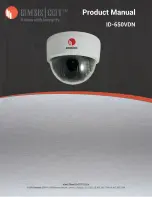
8-3
Appendix
Specifications
+3.3V
0.1
µ
F
10k
Ω
10k
Ω
10k
Ω
Internal contr
o
ller
Input terminals
IN
+
, IN
–
Output terminals
OUT A, OUT B
+
–
External Device I/O Terminals
External Device Input Terminals (IN
+
, IN
–
)
The external device input terminals consist of a + terminal and a ‘–’ terminal. The ‘–’ terminal is
grounded on the inside of the main unit. By connecting two cables to the + and ‘–’ terminals and
then electrically short-circuiting across the terminals (ON) or separating the connection (OFF), an
interrupt can be generated for the internal controller. See “Picture Recording and External Device
I/O Settings Page” in Chapter 3 “Setup Procedures” (
→
P.3-16) for information on the settings.
Connect any sensors and switches to terminals with electrically separate GND terminals and
power supplies.
External Device Output Terminals (OUT A, OUT B)
The external device output terminals consist two terminals (OUT A and OUT B). There is no
distinction b and ‘–’ with OUT A and OUT B. The Internal controller switches the two
output terminals to disconnected or connected condition. The output terminals use optocouplers
and are separate from the internal circuit in the VB-C10/VB-C10R.
* External input status can be checked and external output status can be controlled using Admin Viewer (
→
P.4-25).
Loads connected to the output terminals should be within the following ratings:
Rating across the output terminals: Up to 50 V DC
Continuous load current: 100 mA
Internal Connection Chart








































